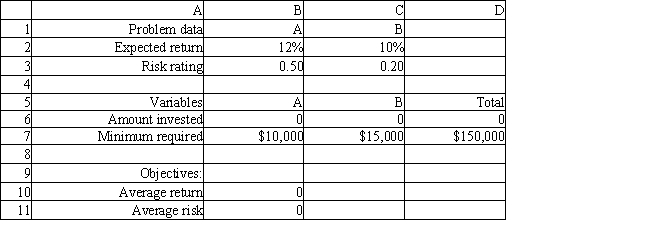Exhibit 7.2
The following questions are based on the problem below.
An investor has $150,000 to invest in investments A and B. Investment A requires a $10,000 minimum investment, pays a return of 12% and has a risk factor of .50. Investment B requires a $15,000 minimum investment, pays a return of 10% and has a risk factor of .20. The investor wants to maximize the return while minimizing the risk of the portfolio. The following multi-objective linear programming (MOLP) has been solved in Excel. 
-Refer to Exhibit 7.2. What formula goes in cell B10?
A) =SUMPRODUCT(B2:C2,$B$6:$C$6) /$D$7
B) =B2*C2+B3*C3
C) =SUMPRODUCT(B3:C3,$B$6:$C$6) /$D$7
D) =SUMPRODUCT(B2:C2,$B$6:$C$6)
Correct Answer:
Verified
Q6: Exhibit 7.1
The following questions are based on
Q7: Deviational variables
A) are added to constraints to
Q8: Linear programming problems cannot have multiple objectives
Q9: If no other feasible solution to a
Q10: Which of the following is false regarding
Q12: The decision maker has expressed concern with
Q13: In the goal programming problem, the weights,
Q14: The di+, di− variables are referred to
Q15: One major advantage of goal programming (GP)
Q16: The deviational variables represent the amount by
Unlock this Answer For Free Now!
View this answer and more for free by performing one of the following actions

Scan the QR code to install the App and get 2 free unlocks

Unlock quizzes for free by uploading documents